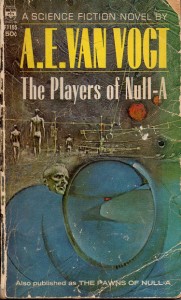Book Review: The Players of Null-A by A.E. van Vogt (Also published as The Pawns of Null-A)
Note: This book is a direct sequel to The World of Null-A and this review will spoil elements of that first novel. Like, immediately after this paragraph.
With the death of the mighty Thorson, the plans of the Greatest Empire for Venus and Earth have been thwarted. But that empire and its master Enro the Red are still active threats to the Galactic League. As well, Gilbert Gosseyn, the man with the extra brain, has come to the attention of the mysterious Follower. Even with the aid of his Null-A training, can Gosseyn survive long enough to learn the true nature of his enemies? And who is the Player who seems to be guiding Gosseyn?
This story was originally published as a magazine serial in 1948, and revised for book publication in the 1950s. It follows van Vogt’s standard formula of short scenes and plenty of plot twists, while using psychologically tricky phrasing to slow the reader down and make them think a bit. Still, the plot practically gallops.
One thing Mr. van Vogt did well was allow his overpowered protagonist to still feel challenged. His training in non-Aristotelian logic gives his cortex (seat of reasoning) mastery over the thalamus (seat of emotions) so that he is able to understand his own feelings and psychology. This has allowed Gosseyn to reach the peak of human mental and physical conditioning. In addition, his apparently unique extra brain allows him to teleport himself and other objects without the aid of machines, as well as other minor tricks. Oh, and if he’s killed, there are backup bodies.
But Gosseyn is up against Enro the Red, a dictator with the resources of an empire and the ability to see and hear events anywhere he chooses; and the Follower, a living shadow with the ability to predict the future. To make things even more complicated, Gosseyn is forced into a different body from time to time, one without any special powers or training to assist him. While if he gets killed, Gosseyn will revive in a new body, he doesn’t know where that body is stored–it could be far from the places he needs to be.
Eldred Crang, the Null-A detective, is also busy, but mostly behind the scenes with his alleged wife (who turns out to be Enro’s sister, and co-ruler of the planet…but with no power over the extrastellar empire.)
There are several competent, strong-minded women in the story, but for reasons, none of them are fully trained in Null-A, so they play subordinate roles. There’s a scene where this book almost passes the Bechdel Test. It seems that Enro has a childish attitude towards women, considering their primary use to be sex objects (including his sister), so Gosseyn has two of them engage in “girl talk” so that if Enro is listening in, the inanity of it will mask the men’s plot-relevant conversation. Doesn’t quite pass the test, as none of the women’s dialogue is quoted.
The ending is very abrupt, like one of those old kung-fu movies that stops at the moment the hero lands a knock-out blow on the villain. Mr. van Vogt was not big on wrap-up chapters, so the fate of several characters is up in the air at the book’s end.
The Null-A philosophy extracts that start each chapter can be a bit repetitious, and one has to wonder just how one leaps from them to rewiring your brain through intense training. There’s also a lot of technobabble around the teleportation system.
You might want to read the previous book first, (try to get your hands on the 1970s revision which fixes some of the worst plot holes in World), but this is perfectly acceptable pulp science fiction that might give you something to think about.

